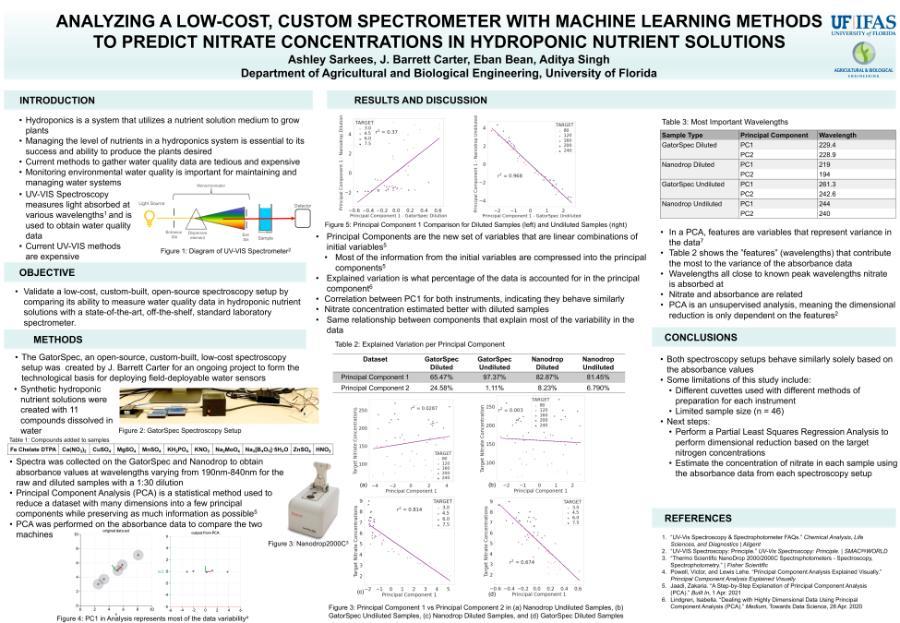The ABE Poster Symposium is an annual event which gives students the opportunity to communicate their research to ABE faculty and department peers. Below are past submissions from undergraduate students and links to download each poster.
-900x810.jpg)
-
Julian Williamson - Ergonomic Risk Assessment in a Greenhouse Nursery Operation - Abstract & PDF Download
Ergonomic Risk Assessment in a Greenhouse Nursery Operation
Julian Williamson
Advisor: Dr. Serap Gorucu
The aim of this study was to investigate the ergonomic risk from repetitive tasks in a nursery operation through non-invasive AI-based techniques. Through discovery of correlation between tasks and ergonomic risk we can make data-driven decisions to improve work conditions.
Abstract:
Florida has the second largest greenhouse and nursery industry of any state in the U.S. and it contributes more than $20 billion to the state’s economy. According to the workers’ compensation data from 2010 to 2019, greenhouse, nursery and floriculture workers had the highest number of injuries; musculoskeletal disorders (MSDs) being the most common occupational injuries. The aim of this study was to investigate the risks for MSDs from repetitive tasks in a nursery operation.
Two highly repetitive and consistent nursery operation tasks in day-to-day operations were selected to make video-based ergonomic assessments. These tasks were moving pots and trays to and from a rolling table and multi-shelf cart. Videos of two people conducting the same tasks were uploaded to KineticaLabs, an ergonomic assessment tool used to generate work task data.
There is minimal difference in the sequential order of joints at most risk for the overall combined tasks for our subjects and relative difference in the order of joints at most risk for individual tasks, given the height disparity between subjects (6’2”, 5’4”). Elbow joints were at a highly disproportionate level of risk for all tasks; thus, there needs to be further investigation into the MSD risk for elbow/wrist/hand joints in nursery operations. We compared combined tasks for specific joints and single-frames to draw conclusions as to which postures are more/less optimal when doing the specific action.

-
Ashley Sarkees - Analyzing a Low-Cost, Custom-Build UV-VIS Spectroscopy Setup with Machine Learning Methods to Predict Nitrate Concentrations in Hydroponic Nutrient Solutions - Abstract & PDF Download
ANALYZING A LOW-COST, CUSTOM-BUILT UV-VIS SPECTROSCOPY SETUP WITH MACHINE LEARNING METHODS TO PREDICT NITRATE CONCENTRATIONS IN HYDROPONIC NUTRIENT SOLUTIONS
Ashley Sarkees
Advisor: Dr. Eban Bean
ABSTRACT:
The goal of this research project was to validate a low-cost, custom-built, open-source spectroscopy setup created in the ABE department at UF (GatorSpec) by comparing its ability to collect water quality data in hydroponic nutrient solutions to that of a state-of-the-art, off-the-shelf, standard laboratory spectrophotometer (NanoDrop2000C) using machine learning methods. Gathering water quality information is important for understanding and managing of water resource systems. For instance, hydroponics is an important water-focused system for crop production, and the correct management of nutrients in a hydroponic system is necessary for producing healthy crops efficiently and sustainably. However, it is relatively expensive and tedious to collect information on water quality using conventional methods. The results of this study showed that the GatorSpec has a comparable performance to that of the NanoDrop2000C and functions well as a UV-Vis spectrophotometer. This low-cost setup can be used to determine nutrient concentrations in hydroponic nutrient solutions.
